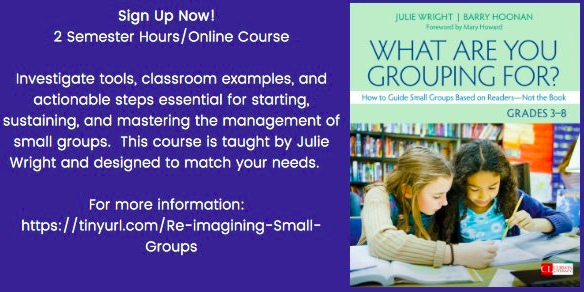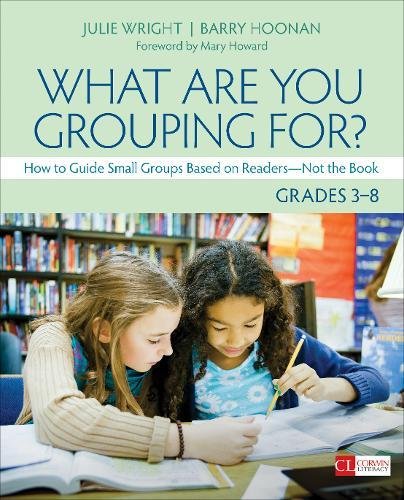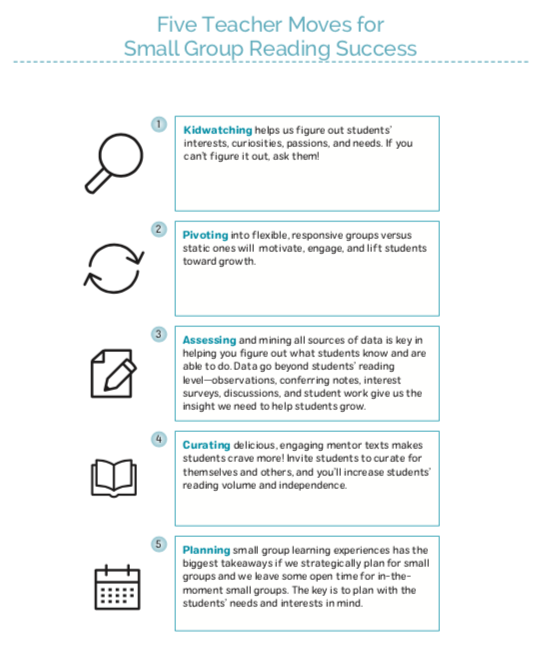Written by: Julie Wright & Barry Hoonan
Proximity matters. That’s because being close creates connectedness. And, this, in turn, creates oneness. Let’s take, for example, when a teacher reads aloud a beautiful picture book or short story to a group of students. Pulling students up close during the experience, rather than spanned out across the room, creates a different feel. Gathering everyone to come close to the center, near the book / text and near the reader, creates a community and a shared purpose. This ups the chances for engagement because we know it’s harder to drift off if you are part of the process. This also ups the chances for participation and learning because the experience can (and should) include dynamic interactions.
While kids are up close and interacting, that’s when we kidwatch in powerful ways. What we see and hear can lead us to making inferences about our students. It can also spearhead wonderings...creating inquiries around students’ insights, ideas, and questions. If we aren’t up close, we might miss it. That’s the principle of proximity in action - having eyes and ears on the ground…in the work…to kidwatch. That gives us the teacher know-how of what to do next for each of our students.
In our new book, What Are You Grouping For? How to Guide Small Groups Based on Readers -- Not the Book, we describe a teacher move called Kidwatching 2.0 which gives us opportunities to use proximity to learn about our students’ curiosities, passions, interests and needs. Our protocol guides teachers to orient, notice, take stock and inquire in order to plan literacy experiences that meet students, collectively and individually. Specifically, this is a new way of thinking about small group learning experiences because being up close to students is what drives discovery. Here’s how it goes.
1. Orient ~ Orient yourself and take a pulse to what’s going on across the classroom.
2. Notice~ What do you see/hear - academically and socially?
3. Take Stock ~ What evidence shows that students are knee deep in the opportunities for learning?
4. Inquire ~ What inquiries do you have about your students?
If you don’t use the power of proximity – being close to students’ conversations, interactions, and work – you risk faulty or misguided kid “intel”. You might risk having outdated information versus “in the moment” data filled with important knowledge to create instruction and learning opportunities for students.
Here’s an example:
A few weeks into a nonfiction reading unit, fourth grade students are working toward these goals:
reviewing and using text structures and features to make meaning of nonfiction texts
answering guiding research questions about a chosen topic
sharing at an upcoming family literacy night
As students collect interesting information to support their inquiry, shared reading serves two purposes:
Making meaning of nonfiction texts about topics that we may or may not know much about
Exploring mentor texts that excite and energize readers - one readers may end up using as a mentor text for students’ nonfiction writing projects
During shared reading, we explored and read excerpts from
London City Trails by Moria Butterfield
Usborne Book of Inventors by Anthony Marks
Professor Astro Cat’s Frontiers of Space by Walliman and Newman
The Biography of Rice by John Zronik
At the conclusion of our shared reading experience for this particular Tuesday, students are reminded that next to our community meeting area are a few tubs with some interesting nonfiction titles they might enjoy individually or with a small group. Before long, there are a few small groups cooking, so I decide to spend a five or so minutes kidwatching in order to keep my finger on the pulse of how these readers are doing in terms of our shared goals as well as their personal reading goals. So I jot in my notebook:
Orient: almost everyone joined in a small group of 2, 3 or 4; some groups had multiple books while two groups chose only one book to read together
Notice: there’s a low hum of student voices across the room; group members are gathered around texts; some group members are standing, some propped up on knees, some on the floor, some at the cafe table, some at the low coffee table;
Take stock: one group used post it notes to mark the layout of the two-page spread that they liked; one group grabbed a big piece of paper and made a list of new knowledge they gained by reading about sharks; one group decided they liked Jenkins book, How to Swallow a Pig and are considering they might borrow from its structure; one group continues to love the dependable structure in the Eyewitness series and they want to design their two-page spread in the same way.
Inquire: should the shark group share out with the whole class during our debrief?; does Josiah (who worked alone, but typically joins a group) want to work alone or need a way in to a small group?; Is the Jenkins book the best model or is it the use of space and bold words that could lift the group members’ own writing? Should i meet with them to noodle ideas?; how will we create shared agreements about a timeline for this project so that there is enough time to investigate, plus time to read, research / answer inquiry questions, draft, edit, publish the two-page spreads, plan out family reading night agenda.
Here’s the interesting part: Developmental reading data on each of the kids was available. And, yes, that’s important information to know. But, on this particular Tuesday (and the days that followed) levels didn’t guide the reading work at the small group table or the students’ inquiry. If a student is a level O and grabbed a book about Kyrie Irving to feed his inquiry, checking the reading level of the book wasn’t the most important move. When kids are interested, have a real purpose for reading about topics they choose, and have access to a variety of books and resources -- their motivation fuels more reading and ultimately their reading success.








